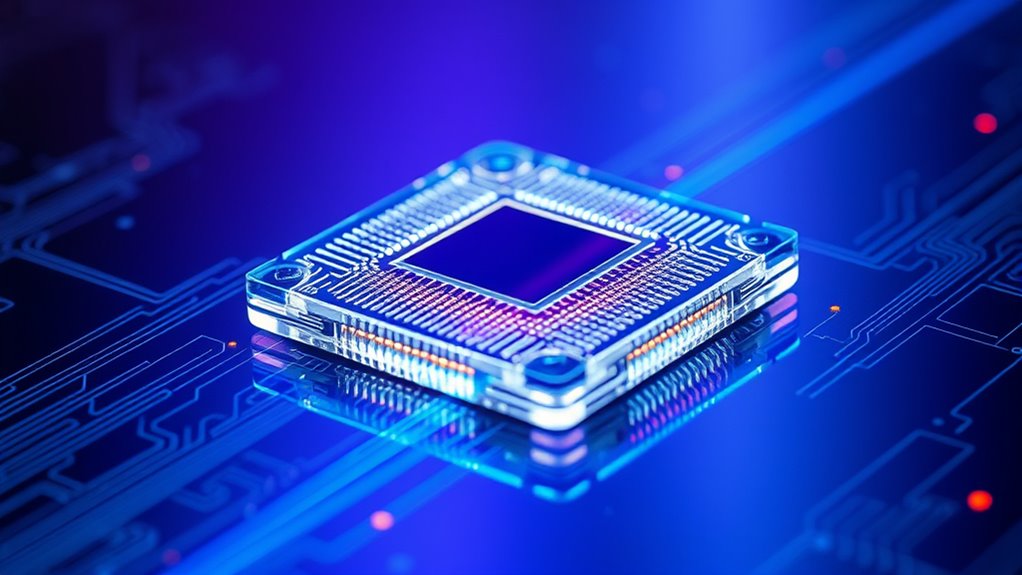Photonic chips enable faster, cooler computing by using light to process data instead of electricity. They can operate 10 to 100 times faster while consuming less energy and generating less heat. Their core components include lasers, waveguides, and detectors that work together for high-speed, low-latency data transfer. This tech boosts AI performance and reduces energy costs. To discover how these innovations are transforming technology, explore how they’re pushing the limits of speed and efficiency.
Key Takeaways
- Photonic chips process data at light speed, enabling significantly faster computing compared to electronic chips.
- They generate less heat and consume less energy, resulting in cooler and more efficient data processing.
- High integration density and 3D packaging reduce thermal issues and improve overall performance.
- Photonic components like lasers and waveguides enable high-speed, low-power signal routing and processing.
- Their energy efficiency helps overcome thermal limits in data centers, supporting faster, cooler AI and high-performance computing.
The Speed Edge of Photonic Chips
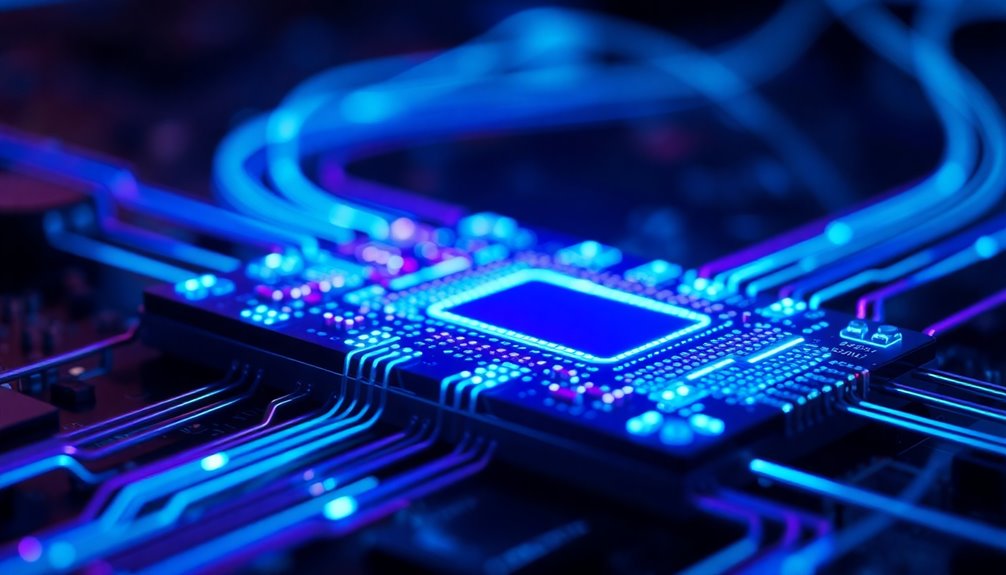
Photonic chips hold a significant speed advantage because they process data using photons that travel at the speed of light. Unlike traditional silicon chips that rely on electrons moving through circuits, photons deliver information almost instantaneously. This allows photonic chips to operate at speeds 10 to 100 times faster than electronic counterparts. For example, a lithium niobate photonic chip can process data at speeds up to 256 gigasamples per second, far surpassing typical electronic chips. High-speed modulation components enable complex tasks, like temporal integration, at bandwidths exceeding 67 GHz. Additionally, color accuracy in photonic components can be optimized to improve signal fidelity, further enhancing performance. The integration of advanced thermal management techniques ensures these chips maintain optimal operation even under high-speed conditions. Implementing system integration strategies helps in seamlessly combining photonic and electronic components for more efficient systems. Moreover, manufacturing processes are continuously evolving to improve the scalability and cost-effectiveness of photonic chip production. Furthermore, ongoing research into material innovations promises to unlock even greater speed and efficiency in future photonic systems. These speed benefits translate into faster image processing, such as cancer cell boundary detection, which is 50 to 100 times quicker than conventional CPUs. This speed edge makes photonic chips ideal for demanding computing applications requiring rapid data handling.
Energy Efficiency and Thermal Benefits
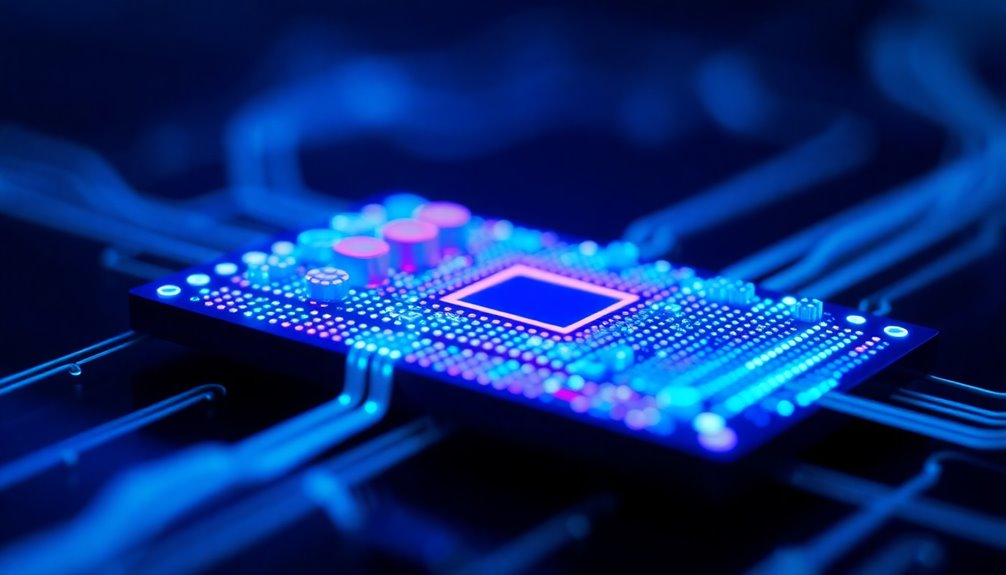
By harnessing light for data processing, photonic chips substantially reduce energy consumption compared to traditional electronic circuits. Photons face less resistive loss than electrons, making data transfer more efficient and lowering power needs. New photonic accelerators consume less energy while maintaining high speeds, especially benefiting AI tasks. On-chip photonic interconnects enable low-energy communication between components, decreasing reliance on power-hungry electrical signaling. While thermal heaters used for wavelength stabilization consume some power, innovations like gate voltage control cut energy use by over a million times. This enhanced thermal management minimizes performance drops and boosts chip longevity. Additionally, the integration of dynamic communication exercises helps optimize system performance and resilience. Less heat generated means simpler cooling systems, reducing operational costs and environmental impact. Incorporating energy-efficient design principles based on recent advancements further enhances overall system sustainability. Innovations in thermal management techniques also contribute to improved heat dissipation and system stability. Furthermore, the cookie management tools help optimize user experience and ensure compliance with privacy regulations. Advances in material science continue to drive improvements in photonic chip performance and scalability. Overall, photonic chips offer a more sustainable, energy-efficient solution for large-scale data processing.
Core Components and Their Functions
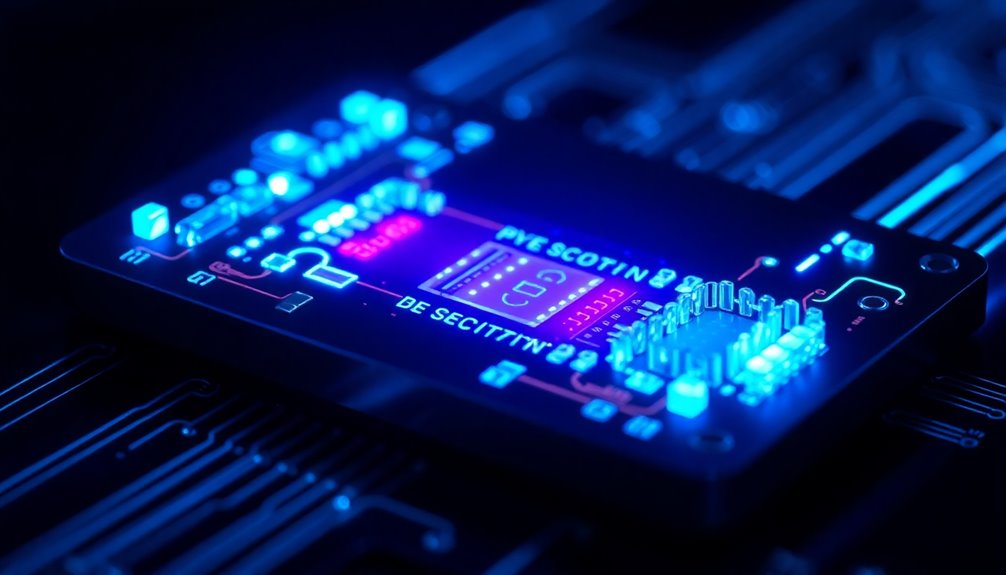
Core components form the foundation of photonic chips, enabling precise control and manipulation of light signals for efficient data processing. Laser sources generate the light needed to transmit information across the circuit. Waveguides direct photons along designated paths, ensuring signals reach their targets. Polarizers control the light’s polarization, improving signal clarity. Phase shifters adjust the timing of light waves, allowing data manipulation. Detectors convert optical signals back into electrical signals for processing. Additional elements like optical filters select specific wavelengths, while amplifiers boost signal strength. Beam splitters divide light into multiple paths, and multiplexers combine or separate signals. Switches redirect light within the chip. Together, these components work seamlessly to facilitate faster, more efficient computing using light instead of electronics. Understanding the importance of natural materials like silica and other substrates is crucial for optimizing photonic chip performance and durability. Advances in material science continue to enhance the efficiency and reliability of these components, making photonic technology increasingly viable for mainstream applications. Moreover, ongoing research into integration techniques aims to further improve chip scalability and manufacturing processes. Additionally, developments in thermal management are essential to maintain optimal performance and prevent overheating in densely packed photonic circuits. Incorporating quality assurance practices into the manufacturing process helps ensure consistent performance and longevity of the chips.
Transforming Artificial Intelligence and High-Performance Computing

Advancements in photonic chip technology are revolutionizing artificial intelligence and high-performance computing by enabling faster, more energy-efficient processing. You can now run complex AI models like ResNet and BERT directly on photonic processors without sacrificing accuracy, thanks to optical computations occurring within sub-nanosecond timescales. These chips support reduced-precision operations, such as 4-bit calculations, maintaining high accuracy while lowering power consumption. With trillions of operations per second and power usage under 80 watts, they handle massive workloads efficiently. Their high integration density, enabled by innovative 3D packaging, combines millions of photonic components with billions of transistors. This synergy delivers ultra-low latency, minimizes heat, and reduces energy demands, transforming AI computation into a faster, cooler process. Understanding photonic integration is key to appreciating how these advances are achieved.
Expanding Applications Beyond Speed and Efficiency
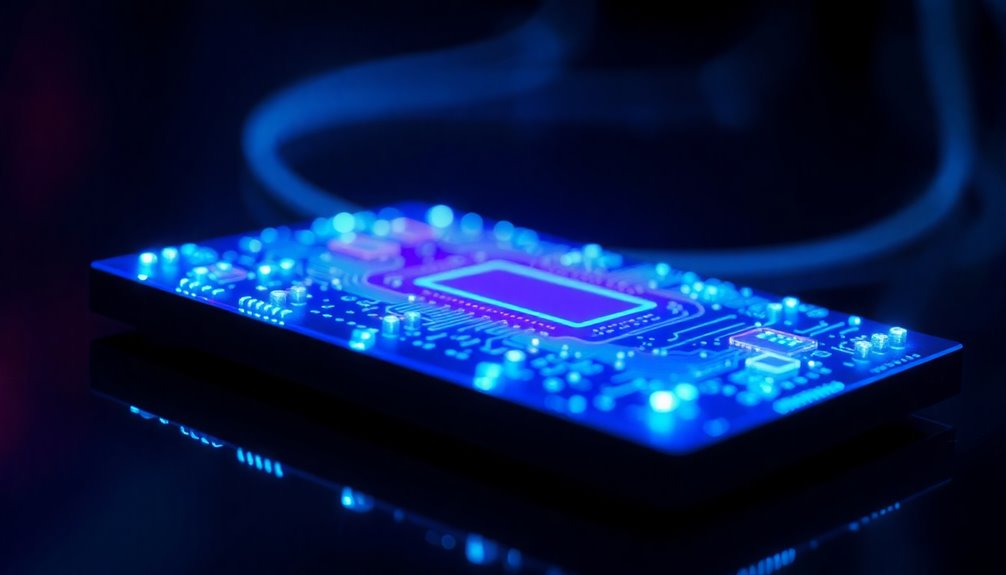
Photonic chips are expanding their reach beyond just speed and efficiency to serve critical roles in various industries. In data centers, they reduce power consumption and overcome thermal limits, enabling higher bandwidth communication between servers and storage. Telecom networks benefit from optical switches that improve real-time data routing, essential for 5G and future 6G capabilities. In defense and aerospace, photonic chips provide interference-resistant processing for cryptography and radar systems. Biomedical fields leverage optical coherence tomography (OCT) for higher-resolution imaging and early disease detection. Additionally, photonic computing supports real-time signal intelligence, enhancing military security and response times. These applications demonstrate how photonics are transforming sectors beyond speed, offering sustainable, scalable solutions with broad societal impacts. Customer reviews highlight the importance of reliability and support in the adoption of these advanced technologies. Furthermore, the integration of email marketing tools can facilitate better communication and stakeholder engagement for organizations involved in photonics development. The ongoing development of photonic integration techniques promises even more compact and efficient systems in the future, with innovations in refrigeration cycle principles contributing to thermal management solutions in photonic devices. As research progresses, thermal dissipation methods are becoming increasingly vital to maintain performance and durability in high-power applications.
Overcoming Technical Challenges and Scaling Up

As photonic chips expand their applications, addressing technical and manufacturing hurdles becomes increasingly important. You’ll need to overcome challenges like laser integration, which demands precise alignment and calibration to guarantee ideal performance. Thermal management is critical; heat dissipation must be carefully designed to prevent hotspots that degrade reliability. Achieving high modulation speeds without sacrificing efficiency remains a key goal. Scaling multiplexers and demultiplexers to handle larger data traffic requires innovative solutions. Improving photodetector efficiency is essential for dependable data transmission. Manufacturing hurdles include limited foundry capabilities, inconsistent process design kits, and packaging density constraints. Ensuring reliable building blocks and managing multi-project wafer runs are crucial for scalability. Additionally, understanding divorce statistics can inform expectations about complex legal and logistical issues in scaling production. Addressing these issues will pave the way for mass production and widespread deployment of photonic chips. Moreover, implementing standardized fabrication processes can help overcome some manufacturing limitations and improve consistency across production runs.
Advances in Silicon Photonics Integration
Have you noticed how silicon photonics is transforming high-speed data transfer and computing? You can now leverage integrated photonic circuits that combine multiple functions on a single chip, similar to how electronic semiconductors evolved. Recent breakthroughs include electrically pumped lasers made from Group IV alloys like germanium-tin, enabling on-chip laser sources compatible with CMOS processes. High-performance modulators and advanced photodetectors improve data transmission and signal processing. Improved waveguides guarantee efficient light transmission, while co-packaged optics enhance overall performance and energy efficiency. Silicon photonics also plays an essential role in AI/ML, quantum computing, sensing, and telecom networks like 5G and 6G. Thanks to CMOS-compatible manufacturing, these innovations deliver scalable, cost-effective solutions that meet the increasing demand for high-bandwidth, energy-efficient systems.
Future Directions for Fully Optical Computing
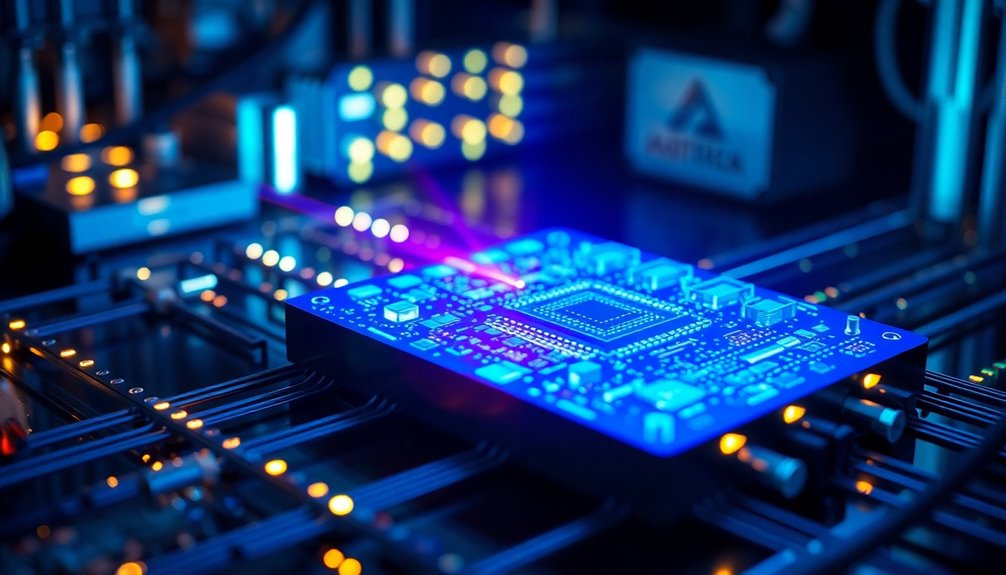
Emerging innovations in fully optical computing are paving the way for new architectures that leverage multi-level photonic processing and in-memory functionalities. You’ll see the development of optical systems that combine storage and processing within the same medium, boosting speed and reducing data movement bottlenecks. These architectures use light interference and phase properties, moving beyond electronic binary logic to analog optical computing with continuous light states. Specialized optical accelerators now target tasks like FFTs and matrix multiplication, offering faster, energy-efficient solutions for AI and neural networks. Progress in optical memory, driven by new materials and device designs, aims to enable stable, low-power storage integrated with computation. Overall, these advancements point toward more scalable, high-performance fully optical systems that could revolutionize computing architectures in the near future.
The Impact on Data Centers and Global Communications

How are photonic chips transforming data centers and global communications? They boost efficiency by reducing energy use through photon-based data transmission, which is more power-efficient than electronics. These chips improve scalability by shrinking the distance between processing and memory, enabling faster, more efficient data handling. Operational costs drop thanks to increased efficiency and lower energy demands, supporting sustainable operations. Data transfer speeds soar with higher bandwidth and reduced latency, allowing real-time analytics and faster AI processing. Photonics also strengthen global connectivity through high-speed, low-energy optical interconnects, making long-distance communication more seamless. Overall, photonic chips revolutionize data centers and networks by delivering faster, greener, and more reliable data transmission, paving the way for advanced applications and a more connected world.
Frequently Asked Questions
How Do Photonic Chips Compare Cost-Wise to Traditional Silicon Chips?
You might wonder how photonic chips stack up cost-wise against traditional silicon chips. While photonic chips offer faster processing and higher capacity, they’re more expensive to produce due to complex fabrication and specialized materials. Silicon chips are cheaper and easier to manufacture, benefiting from existing infrastructure. However, silicon photonics can reduce overall costs by integrating optical functions, making them more competitive as production scales up and technology advances.
What Are the Main Manufacturing Challenges for Large-Scale Photonic Chip Production?
You face several manufacturing challenges with large-scale photonic chip production. Precise integration of optical and electronic components demands advanced alignment and tolerance control, which complicates mass manufacturing. Thermal management is critical to prevent performance issues from temperature variations. Testing needs automation for scalability, but current methods are manual and costly. Packaging remains a bottleneck, requiring better collaboration and infrastructure to enable reliable, high-volume production. Overcoming these hurdles is essential for widespread adoption.
Can Photonic Chips Replace All Electronic Components in Current Systems?
You might wonder if photonic chips can replace all electronic components in current systems. While they’re promising for faster, more efficient data transfer, they face significant hurdles like manufacturing complexity, high costs, and integration issues with existing electronics. So, it’s unlikely they’ll fully replace traditional chips soon. Instead, you’ll see them working alongside electronic components, complementing and boosting overall system performance as technology advances.
How Secure Are Optical Data Transmissions Compared to Electronic Methods?
When considering the security of optical data transmissions versus electronic methods, you’ll find optical systems offer a pretty robust shield. They’re less prone to eavesdropping because tapping fibers disrupts signals immediately, and detecting attempts is easier. Plus, encryption at the optical layer is both high-speed and efficient, making your data safer from cyber threats. Advances like AI and quantum optics further bolster security, giving you confidence in the protection of your information.
What Are the Environmental Impacts of Manufacturing and Disposing of Photonic Chips?
The current question highlights the environmental impacts of manufacturing and disposing of photonic chips. You should know that their production consumes a lot of energy, water, and chemicals, which can harm the environment. Disposal is also challenging due to hazardous materials and e-waste concerns. To lessen these effects, you can support sustainable practices like energy-efficient manufacturing, effective recycling, and developing greener materials, ensuring a healthier planet.
Conclusion
As you embrace the future of photonic chips, remember they’re like the steam engines of the digital age—revolutionizing speed and efficiency. With ongoing innovations, you’ll see faster, cooler computing that outpaces traditional electronics. Just as the telegraph once transformed communication, these chips will reshape AI and data centers worldwide. So, stay ahead, because in this era of rapid change, missing out would be like still relying on carrier pigeons in the age of fiber optics.
